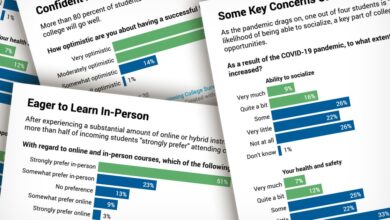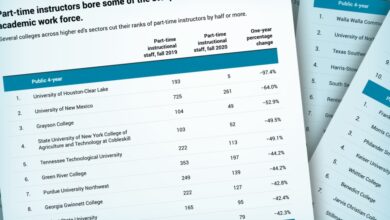‘One Flat Tire Away’

“After that, I kind of piddled around,” Reid said. “I did waitressing, I did little odd jobs, I worked Walmart. Stuff like that.”
Three years ago, Reid decided to throw herself back into education at Lenoir Community College, about 20 miles down the road — a 30-minute trek on long backroads through the countryside — to study medical billing and coding.
It takes a lot of travel to get between home, work, and school. When she was taking classes in person, Reid said she spent at least two hours a day driving.
Reid lives in the home she grew up in, with her mother, brother, and son. She has neighbors to either side, but otherwise, the home is surrounded by fields of corn and collards. Reid’s home lies right on the edge of Lenoir County, about an hour-an-a-half drive southeast of Raleigh. It’s a largely low-income area where nearly one in five people live in poverty, according to the U.S. Census Bureau, and only about 15 percent have received a bachelor’s degree or higher, compared to roughly 38 percent nationally.
Reid’s situation got tougher when the transmission on her old Jeep started to go in the summer of 2021. Replacing it, Reid said, would cost several thousand dollars, and the auto shop couldn’t get one anytime soon.
While her Jeep languished in the shop, unusable, she had to share a car with her mom. She could only work the night shift, starting work at 5:30 p.m. and getting off at 2 or 3 in the morning. On the nights she didn’t work, she took night classes. And during the day she watched her son, who hadn’t yet started kindergarten.
Her options for public transportation were limited. A shuttle bus requires riders to reserve a pick-up at least an hour in advance and is only available weekdays from 3:30 a.m. to 5:30 p.m. And, Reid said, the shuttle bus doesn’t even serve her far end of the county.

Kate Medley for The Chronicle
“I was sleeping five hours a night,” Reid said. “Sometimes less.”
That was when, in November 2021, Reid found out about a program that could get her a working car she could afford. Cars for College, created by Lenoir Community College’s foundation in 2019, thanks to a $250,000 donation, assists working students in buying cars, regardless of their credit scores, to help them access education. The college’s foundation buys the cars (or receives donated vehicles), refurbishes them through the institution’s automotive program, and sells them to students at cost for an average of $3,080. They guarantee loans for students who can’t afford the price outright through a partnership with a local credit union.
After waiting a few weeks for a car with good gas mileage and room for a car seat for her son, Reid purchased a 2003 Nissan Altima from the program for about $3,800. She’s still paying off the loan. “My credit has actually gone up by almost 250 points in the nine months I’ve had this car,” Reid said.
She’s still attending the community college online but with a new dream to eventually become a veterinarian. She works two jobs — at a medical office by day and at an animal shelter on the weekend and some nights.
The Cars for College program was put on pause when the pandemic hit but started getting cars to students at the end of last year. It has awarded 10 cars so far, said the foundation’s executive director, Jeanne M. Kennedy, and aims to disburse 20 per year within the next three years.
“Some students are one flat tire away from dropping out,” said Abigail Seldin, the foundation’s CEO and co-founder.
According to a College Board survey, the average cost of transportation for an in-district, public community-college student during the 2021-22 academic year is $1,840, or nearly 10 percent of the estimated average student’s budget for the academic year.
“We know that many Americans cannot easily manage an unexpected $400 expense,” Seldin said. “When you view transportation access for college students through that lens, it becomes clear pretty quickly that a flat tire is a potentially college-career-ending event.”
Seldin said the issue varies greatly based on location. For many campuses, she said, the problem could be easily solved with more communication between the college and their local transit authority. In North Carolina, for example, 17 percent of campuses are less than five miles from an existing transit line but have yet to be connected.

Kate Medley for The Chronicle
Rural community colleges are an entirely different beast, one that requires new and creative solutions to help low-income students bridge the transportation gap. And one of the unspoken costs of attending those colleges is car ownership.
“Car ownership, or at least car access, is part of the cost of attendance, whether we or the colleges think about it that way or not,” Seldin said. “Right now, it’s illegal to buy a car with your federal student aid. State and local programs that try to fill that gap are doing a critical service for students.”
That’s where a program like Cars for College comes in. Seldin said its model was new to her and that it presented a potential solution for rural campuses.
For students who are not only attending college but are also working and parenting, transportation becomes increasingly complicated. A car, Kennedy said, can be the difference between employment and unemployment in a place like Lenoir County, where public transit is so limited. And having independent transportation means more flexibility for child care, attending classes, and working extra hours.
Nicole Lynn Lewis is the founder of Generation Hope, a national advocacy group for parenting students, and personally struggled to find convenient and affordable transportation as a teen mother putting herself through school at William & Mary, in Virginia. Lewis noted that another reason why young parents shoulder a greater burden to pay for transportation is that college housing simply wasn’t designed with them in mind.
“For parenting students especially, you’re not often able to live on a campus. Only 8 percent of college campuses across the country have family housing available for undergraduate students. So you’re much more likely to be a commuting student,” Lewis said.
When she was a student, Lewis said that even with a car she was traveling 150 miles a day. And time spent driving is a precious commodity. She works with parents who rely solely on public transportation or rides from friends, parents who worry about who will pick up their child if there’s an emergency.
“When you think about even relying on public transportation as a parent, it’s not easy. It’s not just a question of, Is there a metro stop here?” Lewis said.
Seldin said that is one of the shortcomings of her foundation’s transit map, which is meant only to offer a broad picture of the state of community-college public transportation. The maps don’t account for things like routes, frequency, or reliability of transit — all things that could make or break how accessible transit really is.
More colleges are expanding access by providing free or subsidized transit passes — like the Los Angeles Community College District, which will continue its free transit program into this academic year thanks to a $1 million federal grant. But that free transit elapses once a student graduates, whereas in the Cars for College program at Lenoir, students can keep their cars well after they graduate.
Alongside a $250,000 donation from the Z. Smith Reynolds Foundation, a group dedicated to improving quality of life in North Carolina, the college has spent about $107,000 in new equipment and tools for the program. The cars are repaired through the school’s automotive program, giving student mechanics hands-on experience. The cars are also evaluated and tested by a certified instructor, and they carry a six-month warranty.
The limiting factor so far, according to Kennedy, has been getting the cars. According to U.S. Bureau of Labor Statistics data, the average price of used cars and trucks for urban consumers rose by 40.5 percent from January 2021 to January 2022. Even finding cars, let alone affordable ones, was a struggle at the start of the program, Kennedy said. One of her staff members had to get a license to attend car auctions so the foundation could procure cars right from the source. About 35 percent of their cars are donated.

Kate Medley for The Chronicle
But scaling a program like Cars for College, or any transit program, gets expensive quickly. Some rural counties are so loosely populated and the homes of students so far from each other that planning cost-effective transit routes proves extremely difficult.
Some local entities have tried to rectify this problem by partnering across institutions, like Four County Transit in southwestern Virginia. Serving counties with a combined population of about 100,000 people, the transit system consolidates resources to provide a route specifically designed to serve three colleges — Southwest Virginia Community College, Mountain Empire Community College, and the University of Virginia College at Wise.
In 2021, the Providing Assistance for Transit Help, or PATH, to College Act was introduced with bipartisan support to the U.S. House of Representatives. The bill, which gained traction in the House but died in the Senate, would have created a grant process that would allow local entities to partner with their colleges to better support students’ transportation needs, according to Tanya Ang, managing director of advocacy at Higher Learning Advocates, a group that helped draft language in the bill.
“These people that are going to school right now, they’re looking to help their family grow from a socioeconomic perspective. And they want to succeed,” Ang said. “Making it so that they can actually show up to class to be able to do this is going to pay long-term dividends for our economy.”
Lewis, the advocate for parenting students, said that eliminating transportation barriers for parents looking to continue their education creates a two-generation solution to poverty. Parents with reliable transportation access can work more hours and provide more economic stability for their children. It could also mean a better school-attendance record for their children or more access to health care or even healthier food options.
“Oftentimes, we’re looking at parents and children in these silos,” Lewis said. “When you’re supporting a parent in earning their college degree and you’re supporting their child in early-education success and early-elementary-school success, then it’s a powerful symbiotic relationship.”
Reid said that having a car means she can work more regular hours and get more sleep. It means she has the option to pursue more educational opportunities going forward, which could help her toward her goal of opening her own veterinary clinic.
Cars for College is chipping away at what Kennedy said was a long-simmering problem for Lenoir.
“When you have a student who has not had any reliable transportation and they get reliable transportation,” she said, “life is so much better for their whole family.”
Source link






